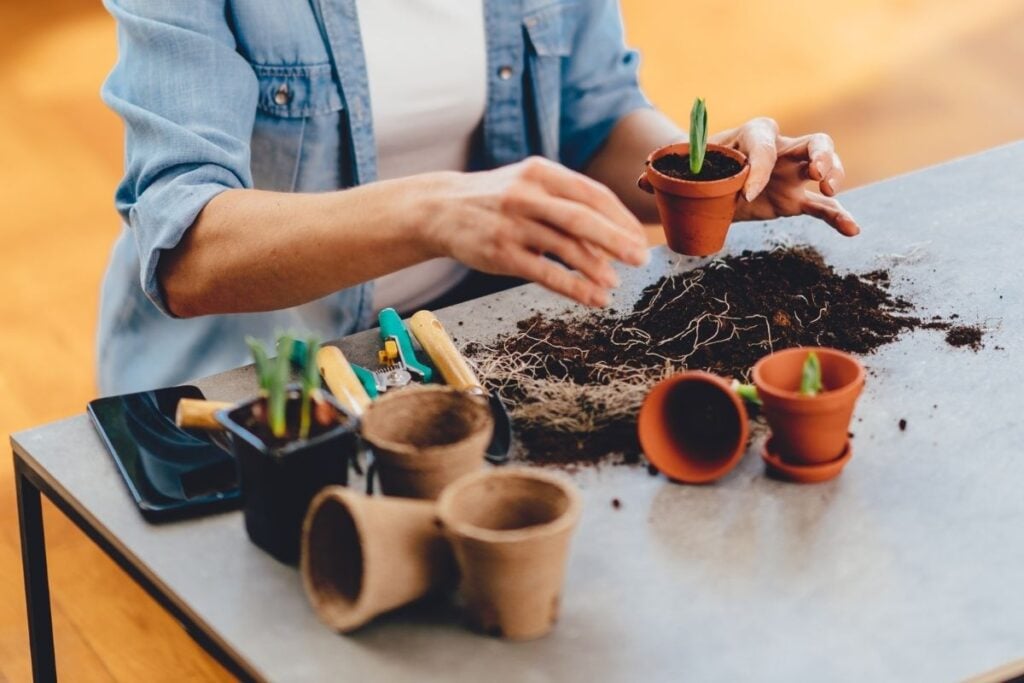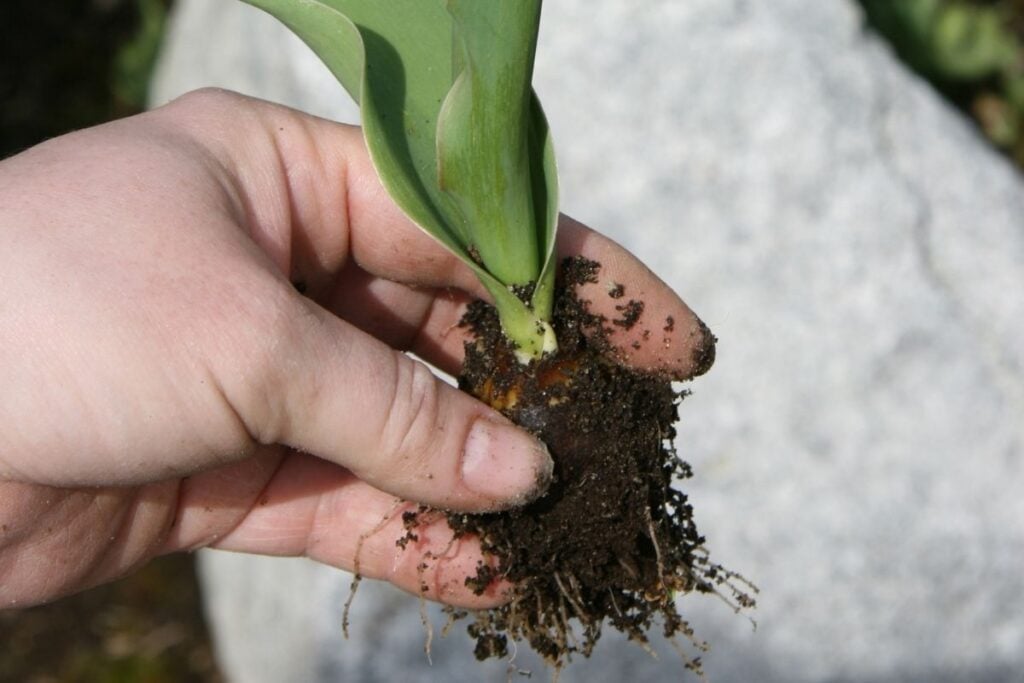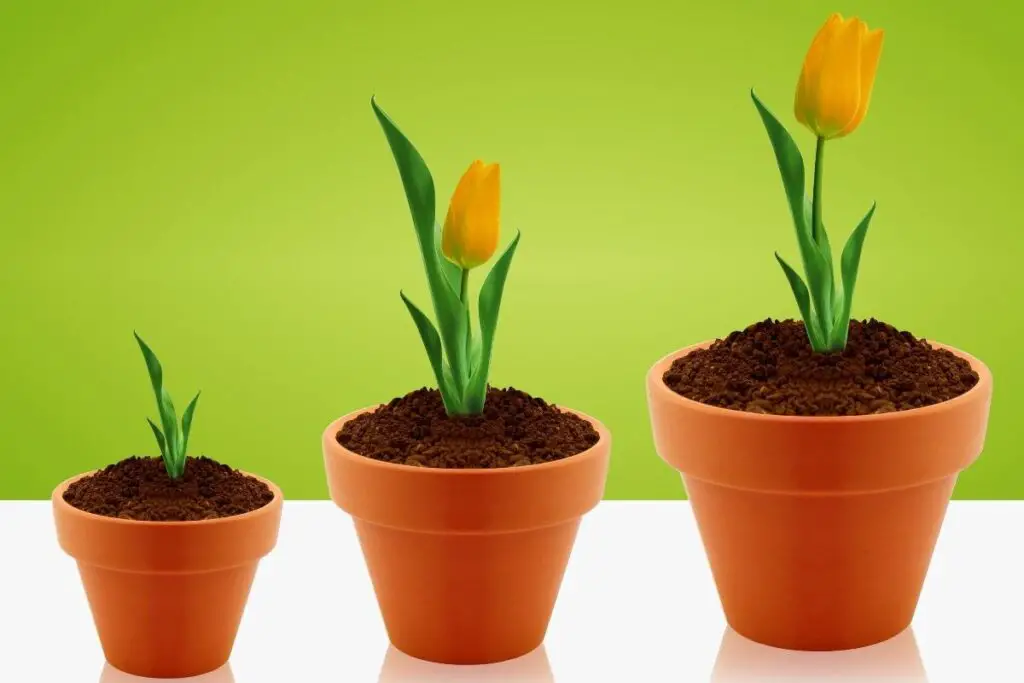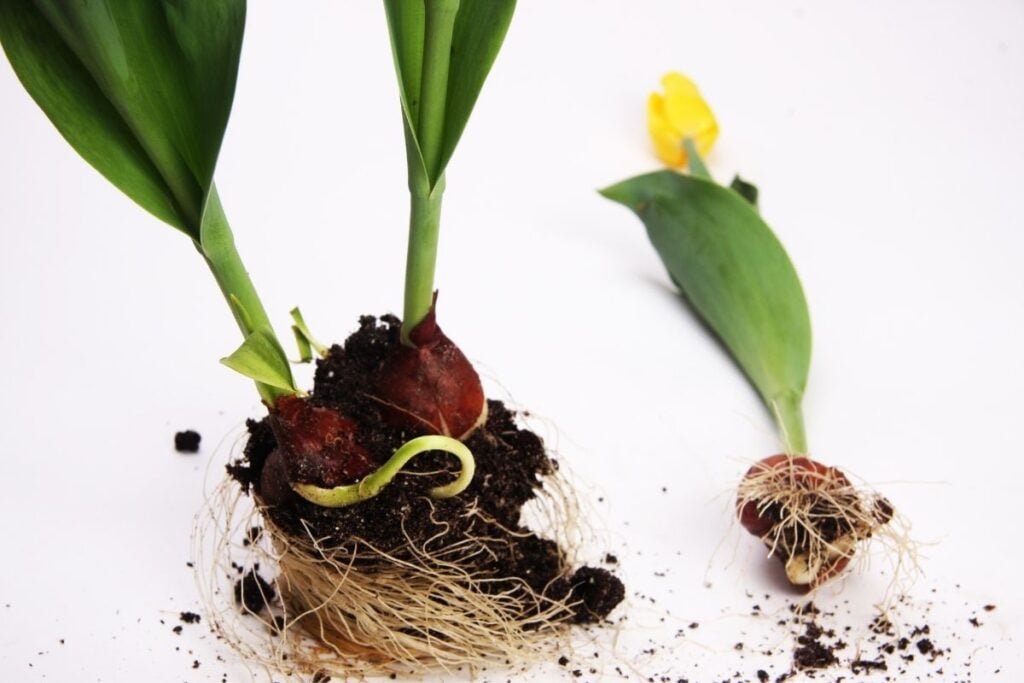Tulips – the flowers that symbolize love and perfection are noted for their vibrant and beautiful colors, primarily red, white, or yellow. You must have seen tulips in the gardens, but people want to grow them in pots inside their houses too.
Let’s find out how to grow tulips in a pot.
Tulips can be grown in pots just like it is grown outdoors in the yard. To grow tulips in a pot, choose a deep pot, fill it with well-drained soil and plant the tulip bulb 8-9 inches deep. Water the soil whenever the top layer feels dry and move the plant under the bright direct sun.
One thing that should be recommended while planting the tulip bulbs is that the chances of them blooming again are rare, and buying new ones is always the better option for your beautiful spring garden.

How to plant tulips in pots?
Tulips can grow in pots and make your balcony or window sill look beautiful. Let’s have a look at the basics of potting the gorgeous tulips.
Plant tulip bulbs the right way.
Take a container and fill two-thirds of it with the appropriate potting mix.
A porous fast-draining soil works the best for tulips with ample organic matter, as tulips do not grow very well in clayey soil.
Perlite and vermiculite mixtures work great for potted tulips.
Several layers of tulips are planted one on another with quality compost in between. Tight circular patterns also work for tulips.
For additional support, a wire grid can be placed on top of the soil, and then you can cover it with the potting mix. The flat side of the bulb should be deep enough into the soil to hold it in place and make them firm.
Looking for gardening supplies? We have tested 100's of products before recommending them to you guys. Check out our best pick below:
| Image | Gardening Supplies | Best Price? |
|---|---|---|
 Top
Top Top
Top | Raised Garden Bed Kit | Check On Amazon |
 | XLUX Soil Moisture Meter, Plant Water Monitor, Soil Hygrometer Sensor for Gardening, Farming, Indoor and Outdoor Plants, No Batteries Required | No Results |
 Top
Top Top
Top | 82 Pcs Garden Tools Set and Extra Succulent Tools Set | Check On Amazon |
 | Joeys Garden Expandable Garden Hose with 8 Function Hose Nozzle, Lightweight Anti-Kink Flexible Garden Hoses, Extra Strength Fabric with Double Latex Core, (50 FT, Black) | No Results |
 Top
Top Top
Top | Dual Chamber Compost Tumbler | Check On Amazon |
 Top
Top Top
Top | Sunnyglade Plant Stakes | Check On Amazon |
 Top
Top Top
Top | Organic Cold Pressed Neem Seed Oil | Check On Amazon |
 Top
Top Top
Top | Mighty Mint Gallon :-Insect and Pest Control Peppermint Oil | Check On Amazon |
 Top
Top Top
Top | Scotts DiseaseEx Lawn Fungicide | Check On Amazon |
 Top
Top Top
Top | Jacks Classic 20-20-20 All Purpose Fertilizer | Check On Amazon |
 Top
Top Top
Top | 30,000 Seeds Pollinator Attracting Wildflower Mixture | Check On Amazon |
 Top
Top Top
Top | Survival Vegetable Seeds Garden Kit-Over 16,000 Seeds | Check On Amazon |
Take care of the temperature.
The goal is to keep the potted tulip containers dry, insulated, and cold. That is, just above the freezing temperature.
An appropriate place for this condition is an unheated garage, and refrigeration will also work.
Henceforth the potted bulbs will not need watering till early spring. After lightly watering and checking on the pots at the onset of spring, the tulips ought to start peeking above the soil surface.
Right at this point, the pots can be brought out on display and watered usually. Once the blooms fade, you can transplant the bulbs into a sunny bed.
Basic steps for potting tulips

If you plan to grow tulips in pots, read the following steps so you know how to do it right.
- Select a terracotta, ceramic, or plastic pot with suitable drainage holes for the bulbs. Larger pots will hold more flowers. A pot of 22 cm can hold 2-9 tulip bulbs.
- Now fill the pot with the potting mix. A potting mix is always better than the average garden soil as it has more nutritional elements and water-retaining capacity. The pot needs to be filled halfway with this potting mix.
- Now push the bulbs into the soil with an appropriate spacing technique: a 1-inch gap between the bulbs. The pointed ends of the bulbs need to face upwards. If the number of bulbs is more, you should increase the supply of water and nutrients too.
- Henceforth, the bulbs need to be covered with the same potting mix.
- You can plant another layer of bulbs for a layering effect or denser tulip growth, provided the previous bulbs are well covered with potting mix or soil.
- Water the bulbs now thoroughly, making sure the excess water drains out.
- For approximately ten or more weeks, keep the pots in a place that maintains a temperature range of 45-55°F. Maintain consistent temperature to avoid the risk of freezing and thawing.
- After the dormancy phase is over, the tulips should start blooming if the conditions are proper.
- Now, you can shift the tulips to a place with proper sunlight and temperature at least 60-70°F
- Depending on the group of tulips, it should start blooming approximately after 1-3 weeks.
Importance of choosing the suitable container for tulips
Various aspects need to be kept in mind while choosing a container.
- Tulips require proper drainage, so a container with proper holes works the best for tulips.
- The selected container preferably should be kept outdoors year-round so that it does not crack in cold winters.
- You must plant the tulips deep in the soil to keep them unaffected, even if it’s too warm or cold.
- The container should be deep enough. The minimum diameter should be 18”, and a height of 15” is necessary for the flowers to thrive.
Factors influencing the growth of potted tulips
You must consider the following factors while growing tulips in pots.
Watering: Moist yet well-draining soil is the topmost requirement for the growth of the tulips. You must water the tulips until it starts dripping from the bottom of the pot. You must water the tulips at least once a day.
Drainage: A proper drainage is required for the thriving of the tulips. After adequate watering, the pot ideally should drain for 30 minutes before collecting the moisture. While selecting a proper container, you should check these.
Temperature: In the initial stages, cold storage works best for the potted plants. Tulips need a specific low temperature to break their dormancy.
Tulips respond well to force blooming, which lets the tulips thrive earlier than other flowers in a warmer or general climate. 35-48°F is the suitable temperature for these flowers for around 10 weeks.
If the outdoor temperature does not permit the same, refrigeration might work. After the shoots start emerging, the pots should be taken out of cold storage and kept at a temperature of 50-70°F where sunlight can reach.
Soil and fertilization: Sandy soil with good organic matter and less clay works the best. The soil must be loose and airy.
A peat-free compost with added organic matter such as humus, compost, sawdust, moss is always beneficial for the plants.
Potted tulips won’t need chemical fertilizers due to the ample availability of nutrients, especially in the tulip bulbs.
Also read:
- How Much Sunlight Do Tulips Need? (Tulip Light Needs)
- How Often Do Tulips Need To Be Watered? (Tulip Watering Needs )
- What Kind Of Soil Is Good For Tulips? (Best Soil Mix)
- What Is The Best Fertilizer For Tulips? (Organic+Inorganic)
- What Temperature Do Tulips Need? (+Growing Them At Different Temperature)
- When To Plant Tulips Seeds? (Guide As Per Your Zone)
Blooming as per the type of tulips
The blooming of tulips varies on its group as well. Depending on the type of tulips planted, you can estimate their thriving time.
Mixing and matching of groups in the pot can even prolong the blooming duration of tulips.
Following are some types and their blooming time.
- Early Bloomers: Double early, fosteriana, single early
- Mid-season Bloomers: Darwin hybrid, fringed, triumph
- Late bloomers: Double late, parrot, single late
Problems found in potted tulips

Blooming tulips signify beauty and glory. Similarly, wilting tulips indicate an end to a life. There can be many underlying reasons for it. Let us have a look.
Life span: The general lifespan of tulips is short. They bloom in spring and naturally die shortly after. The petals drop and stem droop.
If the conditions are right, though it’s a rare event, the nutrients return to the bulb so that it can re-grow in the following spring.
Environmental views: Improper drainage, overwatering can destroy the roots of the plants. Hence a proper pot and soil check is of utmost importance.
Excess sunlight can be harmful to the plants, so you should control the temperature correctly.
Plant size: If the tulips grow up to 2 ft, then the slender stems often fail to support them after the flowers bloom; hence they start to die.
So often, flowers are cut and enjoyed in vases.
How to care for the potted tulips?
The stunted growth with yellow patches in the tulips is often a sign of disease caused by Nematode. In cases where such diseases develop, the affected bulbs need to be discarded at the earliest to prevent infection.

Fungal infections cause some common diseases in tulips:
- Basal rot
- Root rot
- Tulip fire
Hence the growth of white fungus on tulips has to be prevented.
A proper fence or mesh over the soil might also protect the pots from squirrels and similar animals and aphids.
A constant check for blights in the tulips is a necessity. It creates a brown speck on the leaves and turns the flowers grey in color.
Apart from these, it is crucial to check for any insects or pests’ outgrowth. Proper spraying and disinfection are required in that case.
The temperature, drainage facilities, and other factors are mandatory for flourishing blooms of potted tulips.
In some cases, the tulips, after undergoing the cold treatment, may have some yellow shoots. In that case, an adequate amount of sunlight can make the same greener.
Improper cold storage is a strong reason for blooming failures. Only healthy plump bulbs which have ample nutrition are ideal for forcing.
Weak or bulbs being potted for the second time do not have the right amp of strength for forcing.
Potted tulips in the off-season
Tulips naturally bloom with the onset of spring.
We also know it stores its nutrition in the bulb. So using this quality with the proper potting technique, it can also bloom in December.
The same steps need to be followed just with some extra effort in keeping the temperature in check.
With advanced scientific technology, beautiful hybrid tulips are grown in pots, even in the offseason. The primary focus should be on the health of the bulbs. Proper nutritional supply and watering go a long way.
Source: Wikipedia, North Dakota Stae University, The Royal Horticultural Society.
